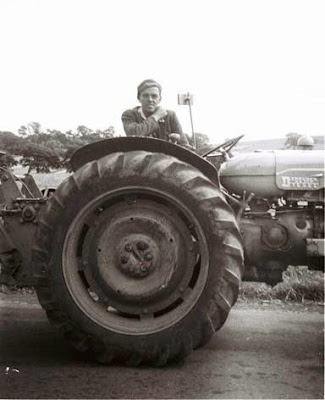Sepia Saturday give bloggers an opportunity to share their family history
and memories through photographs.
and memories through photographs.
 This week's prompt shows a water wheel, a once prominent sight in the Scottish Borders where I live, as a symbol of the textile mills which developed alongside the many tributaries of the River Tweed. Before modern industrialization, water was the main power source for industry in Scotland.
This week's prompt shows a water wheel, a once prominent sight in the Scottish Borders where I live, as a symbol of the textile mills which developed alongside the many tributaries of the River Tweed. Before modern industrialization, water was the main power source for industry in Scotland. In Hawick, Tower Mill, built in 1852 over the Slitrig Water, is noted for having the largest surviving waterwheel in a textile mill in southern Scotland. During the 19th century, water power was superseded by steam power, and tall chimneys came to dominate the town's skyline.
But the massive 14 foot wheel was the first in Hawick to generate electricity in 1900. As part of a Hawick major regeneration scheme, Tower Mill reopened in 2007 as a multi functional arts centre. The waterwheel is still visible from above through a glass flooring.

A tractor in Earlston - with a very big wheel!
Cartwheels in the stable yard at Beamish Open Air Museum in North East England
A carter delivering goods in Earlston
A Church Choir Outing in Earlston, 1907 -
with those four carriage wheel looking rather flimsy for all the people on board.
A powerful view of the giant wheel on a steam train
on the North Yorkshire Moors Heritage Railway at Grosmont.
A visit to the National Railway Museum at York where our daughter enjoyed playing gymnastics on the giant wheels.
The London Eye - we stayed in a hotel round the corner from the Eye on the south bank of the River Thames and every evening enjoyed this lovely view. The structure, the world’s tallest cantilevered observation wheel, opened December 31st 1999 and was originally called the Millennium Wheel.
And a final thought - how many of you can look back on singing endless times
With thanks for Auld Earlston for the vintage photographs from their collection
Wheel away HERE to see more contributions from Sepia Saturday bloggers.









Interesting post! Love all the different wheels, and the precarious wagon of choir folks!
ReplyDeleteI got interested in mills as my ancestors owned the flour and grain mills in Devon, England. When my 2x ggf came to Canada he went straight away to work at the mill.
A grand accounting of wheels in all shapes & sizes. I'd love to be able to ride the Millennium Wheel (why did they stop calling it that?), but for one thing, I'm too far away; and for another, I'd freak out. Once upon a time I could have done it - when I was much younger. But around about age 25 I could no longer ride on things like Ferris wheels and rollercoasters & etc. Oh well.
ReplyDeleteAn interesting selection of wheels!
ReplyDeleteThat picture of your daughter’s gymanastics is wonderful, in fact it’s wheely good!
ReplyDeleteLove the pun!
DeleteIt's good when places like Tower Mill can be preserved in that way, and I agree, that is a great shot of your daughter hanging fom the axle!
ReplyDeleteI really liked the history lesson of Tower Mill, and then to finish off the posts with a great assortment of wheels and pics. Thanks.
ReplyDeleteI never thought to do other wheels -- great take on the post!
ReplyDeleteI wonder how many people fell off the choir wagon on their way around town?
ReplyDeleteI agree that that choir probably was hanging onto each other at least from that wagon...and I'm with you and no longer liking heights. Great wheels!
ReplyDeleteAnd round and round they go! Oddly enough the London Eye was probably the quietest wheel of all of them.
ReplyDeleteI'd never heard of an existing water mill being converted to generate electricity. Very modern!
ReplyDelete